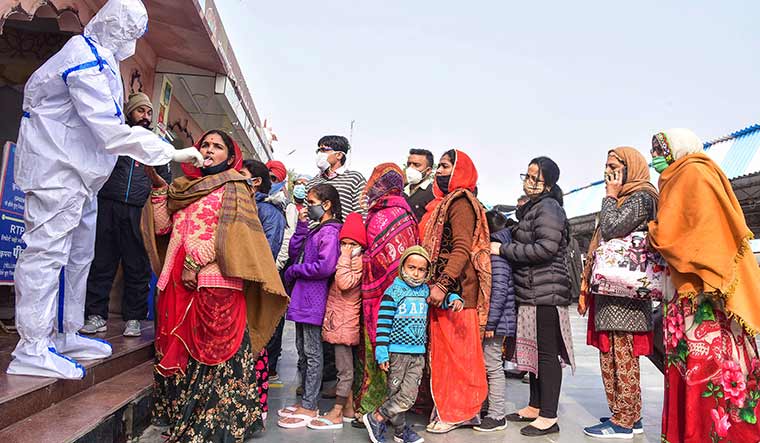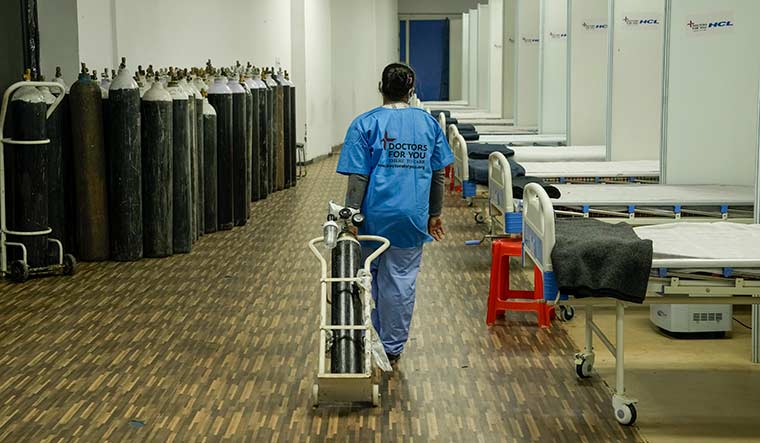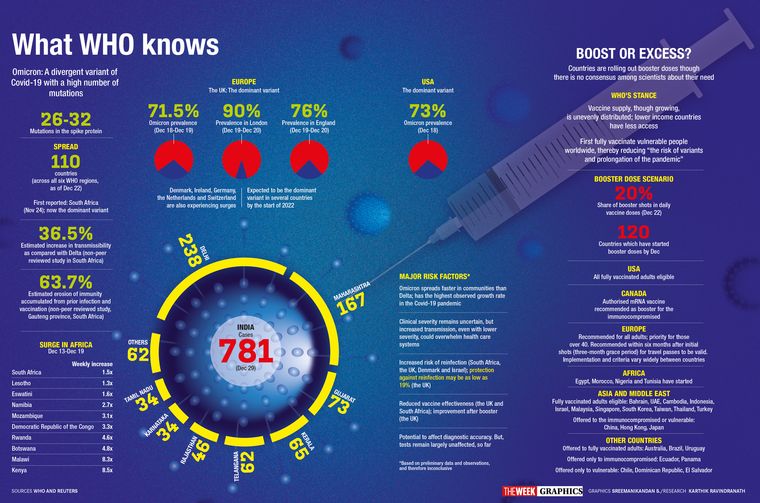The latest season of variant vs vaccine is playing out. While the vaccines are still running on the original version, the variant is on to its third aggressive update. The vaccines were designed with the original Wuhan template, even though they factored in the possibility of virus mutations. Yet, the Delta variant, which emerged last winter, succeeded in breaching the vaccine immunity. Omicron, this season’s buzzword, is not just three times more infectious than Delta, but has around 30 mutations, because of which it is not just breaching the vaccine barrier, but also the immunity acquired from a past infection.
The government is rolling out two new vaccination schemes—inoculation of the 15-18 age group and a booster or protection dose for frontline workers and senior citizens from the new year. With new developments daily on Omicron’s superpowers in breaching barriers, the question that naturally pops to mind is just where are we headed.
With less than a thousand Omicron cases reported in the country (the overall cases are still around 75,000), it may be too early to say what is in store for India, although studies like those of IIT Kanpur are predicting the wave to peak in February. The good news, say experts, is that Omicron, while a furious spreader, appears to be milder. “Unlike Delta, which went straight for the lungs and took the breath away, Omicron shows an affinity for the upper respiratory tract, causing more symptoms of cough and cold,” said Jayaprakash Muliyil, chair of the National Institute of Epidemiology’s scientific advisory committee.
Omicron’s mildness, however, could be deceptive. “Mild symptoms mean that people may not go for testing, thus the RT-PCR numbers may not be an accurate indicator of the spread,” said Rakesh Mishra, director, Tata Institute for Genetics and Society, Bengaluru. Take the present reported figure, less than a thousand for a country of India’s size in two weeks since the first reporting. This, when the west is reporting a doubling every second day. So, are we still too early to see the doubling, or are we missing out on the positive cases by a huge margin already? The variant’s mildness might morph into something serious, one cannot say. “Thus, the authorities need to train their eye on hospital admissions. The trend will emerge from there,” said Muliyil.
Many experts believe that India’s Delta exposure itself may ensure that Omicron will not create a public health havoc. Around 145 crore vaccine doses have been administered, a majority has received the two shots. In addition, repeated seropositivity tests indicate that around 80 per cent of the country has antibodies—either through infection or vaccination. Vaccines, as Mishra emphasised, are known to reduce the severity of the disease, and lower hospitalisation rates massively. Thus, the dominant argument right now is that while Omicron will certainly spread, its impact on public health will be minimal. Most patients might just escape with a more serious version of the common cold. “Omicron might just erase the immunological gap in the population, I do not see it as a variant of public health concern,” said Muliyil.
A small study in Kerala bolsters this confidence. Rheumatologist P. Shenoy in Kochi was studying immunological responses to the vaccine among his patients, and he discovered that those who had acquired “hybrid immunity’’ had the highest titers of antibodies against the Sars-Cov-2 virus. “We were studying patients on immune response and we discovered that those who had got the infection, and then, one dose of the vaccine, had the highest titer of antibodies, almost 25 times higher than those who had got two vaccine doses but no infection,” said Shenoy. The study was published in the medical peer journal Lancet some weeks ago.
The discovery is significant from the Indian perspective because thanks to the two waves—caused by the original Wuhan strain and Delta variant—a large swathe of Indians has infection-acquired antibodies. Asymptomatic infection was a characteristic of the original Wuhan strain. The steady vaccine coverage also means that a significant population has received at least one shot. Thus, Indians are, in a sense, super-powered with hybrid immunity. South Africa had a similarly bad Delta wave, but it was not followed up with robust vaccination coverage. The UK and Israel, on the other hand, had good and early vaccination coverage, but their infection rates were also low, explained Shenoy.
Vaccination and masks remain the most important defence against the virus still, emphasised Mishra. “Repeated studies show vaccines reduce the severity of the infection and the need for hospitalisation,” he said.
The Delta experience in the summer of 2021, however, shows that a certain smugness could be fatal. Authorities this time aren’t taking the chance. If the virus has shown one pattern, it is to expect the unexpected. A third wave was predicted, and the country had worked towards stocking up supplies and ramping infrastructure towards this eventuality. The national capital has already declared a yellow alert and imposed a mini lockdown.
It may be too early to say whether India manages its third wave well. But Omicron indicates that the virus hasn’t tired yet, it is not at the end of its evolutionary journey and may have many more nasty surprises in store. The foreseeable future appears to be one where Covid appropriate behaviour and booster doses will dominate. And just how long could the battle between vaccine and variant continue? Till a time when the virus tires and settles into a non-aggressive existence. Or a time when humans develop a vaccine that gives lifelong immunity against this virus. It is a sobering thought that there isn’t a vaccine against many viruses yet, including HIV. On the other hand, this was the first time in human history that vaccines rolled out within a year of a new disease. And this is only the first version of the vaccine.




